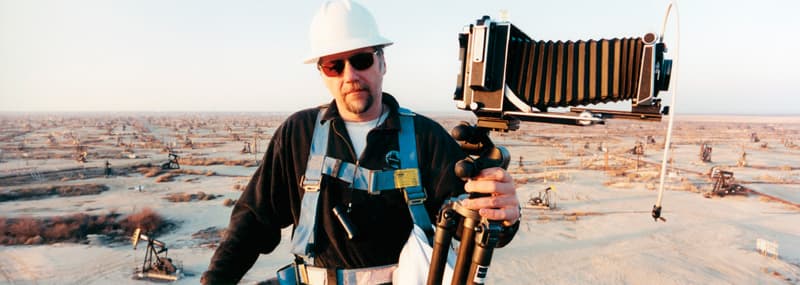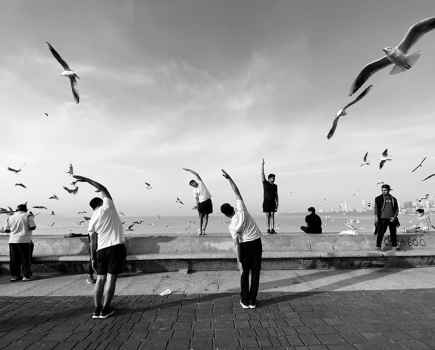Image: Edward Burtynsky on location. His book, Burtynsky: Oil, won the prestigious Kraszna-Krausz Book Award in 2010. © Edward Burtynsky. Courtesy Nicholas Metivier. Toronto
Edward Burtynsky is both a passionate advocate for the environment and one of the most acclaimed fine-art photographers working today. Using 5x4in equipment to produce large-scale images, Burtynsky documents ‘manufactured’ landscapes created by humankind’s ceaseless drive for progress.
His images of locations such as oil refineries, quarries, factories, and refuse and recycling plants are stark and coolly observed, yet carry a powerful environmental message. He focuses on the products, resources and materials we use, what we do with them and what happens when they reach the end of their life span.
Burtynsky was born in Ontario, Canada, in 1955, to Ukrainian émigré parents. His father worked at the local General Motors plant and Burtynsky developed an interest in industry at an early age. His father also encouraged Edward’s passion for photography by buying a second-hand set of cameras, lenses and darkroom equipment, and helping his son shoot and print his own work.
In his teens, Burtynsky worked as a printer before studying graphic arts and photography at college. He graduated in 1982 with a Batchelor of Applied Arts in photographic arts from Ryerson University in Toronto.
Influenced in his formative years by the work of Ansel Adams and Edward Weston, Burtynsky chose to use large-format equipment to attain a high degree of clarity and detail in his images. However, instead of presenting an idealised vision of the beauty and grandeur of nature, Burtynsky used the 5x4in format to focus on how nature had been compromised and subjugated by human activity. His first two series of images, titled ‘Mines’ and ‘Homesteads’, were shot between 1983 and 1985.
The ‘Mines’ project in particular established Burtynsky’s style, subject matter and themes, showing vast areas of land that had been excavated for open-cast copper and coal mining. These landscapes are usually shot in overcast conditions, without dramatic lighting or obviously emotive content, and leave viewers to form their own opinions about what they are seeing. What’s immediately striking about these images, particularly in Burtynsky’s large prints (typically up to 60x50in), is the sheer size of the landscape that’s been plundered.
 Image: Oxford Tyre Pile, Westley, California, USA, 1999. In the late ’90s Burtynsky began to focus on waste. © Edward Burtynsky. Courtesy Nicholas Metivier. Toronto
Image: Oxford Tyre Pile, Westley, California, USA, 1999. In the late ’90s Burtynsky began to focus on waste. © Edward Burtynsky. Courtesy Nicholas Metivier. Toronto
‘The one operating principle in my work is scale,’ Burtynsky told me in 2009. ‘Human beings taking things from nature to provide for themselves is not new, but the scale is. So if I wanted to photograph a quarry, I’d look for the biggest to show the gigantic proportions of what we take from the land.’
In 1985, Burtynsky established the Toronto Image Works, which has gone on to become a darkroom rental facility, a digital imaging centre, a new media training centre and gallery space. At the same time he continued with his own environmentally focused photographic work, with projects including ‘Railcuts’ (1985) and his first series of quarries (1991-92).
In the 1990s and early 2000s, Burtynsky’s focus moved from the effects of gathering raw materials and industrialisation to include the waste produced at the end of a product’s life. He photographed mountains of used tyres and oil drums, and the wastelands created around the ship-breaking and ship-recycling industries.
Many of Burtynsky’s themes were drawn together in a three-year project on China, which was published in book form in 2005. Over a number of visits, Burtynsky documented the effects of China’s rapid industrialisation, including the Three Gorges Dam project that involved the creation of the world’s largest hydroelectric dam.
As in the rest of his work, his China project concentrates mainly on the material world. When people are included in the images, it will be either as identically clothed, regimented and almost dehumanised members of the industrial workforce or impotent bystanders dwarfed by the scale of the changes being forced upon them.
In recent years, Burtynsky has focused the oil industry because, he said, ‘It occurred to me that all the vast, man-altered landscapes I’d been in pursuit of for over 20 years were all possible because of the discovery of oil and the mechanical advantage of the internal combustion engine.’
The results of this ten-year project – documentary images of oil extraction, consumption and disposal, and the environmental effects of our economic dependence on this resource – were exhibited internationally and published as Burtynsky: Oil in 2008. This work was given a devastating postscript in 2010 when Burtynsky made a series of photographs of the Deepwater Horizon oil spill in the Gulf of Mexico. Again, he avoided close-ups of stricken wildlife or polluted beaches and photographed the unfolding tragedy from a distant aerial perspective to emphasise its magnitude.
 Image: Highway 1, Los Angeles, California, 2003. Burtynsky uses large-format equipment to achieve a high degree of clarity and detail. Edward Burtynsky. © Courtesy Nicholas Metivier. Toronto
Image: Highway 1, Los Angeles, California, 2003. Burtynsky uses large-format equipment to achieve a high degree of clarity and detail. Edward Burtynsky. © Courtesy Nicholas Metivier. Toronto
As industry rapidly develops around the world, Burtynsky will not be short of subjects while continuing to explore the contradiction between our need for raw materials and our concern for the world’s future.
His photographic mission is clear. ‘I try to find subjects that are visually compelling and tweak people’s sense of wonder,’ he told me. ‘I want people to stop and ask questions about that subject or place – to think about what they are looking at, where it is, how it got there and why it is being shown. I want to get people to think about their world a little more through the things I photograph.’
Biography
- 1955 Born to Ukrainian parents on 22 February in Ontario, Canada
- 1974-76 Studies graphic arts at Niagara College, Welland, Ontario
- 1982 Graduates with BAA in photographic arts from Ryerson University, Toronto
- 1983 Begins work on his first major photographic projects, ‘Mines’ and ‘Homesteads’
- 1985 Founds Toronto Image Works – initially a darkroom rental facility and custom lab, which later expands to incorporate digital imaging and a gallery space
- 2005 Awarded the prestigious TED (Technology, Entertainment, Design) Prize
- 2006 Named an Officer of the Order of Canada. Burtynsky was also the subject of an internationally acclaimed, award-winning documentary film titled Manufactured Landscapes
- 2007 Burtynsky: Quarries is published in book form
- 2008 Publishes Burtynsky: Oil, which is nominated for the Deutsche Börse Prize and wins the Kraszna-Krausz Book Award in 2010
Books and Websites
Books: Books currently in print include Burtynsky: China (published by Steidl, 2005), Quarries (Steidl, 2007) and Oil (Steidl, 2008). A selection of work from his 25-year career is available in Manufactured Landscapes: The Photographs of Edward Burtynsky (Yale University Press, 2009).
Websites: Burtynsky’s official website is www.edwardburtynsky.com. It features biographical material and images from over ten portfolios of work, plus several video interviews with the photographer.








